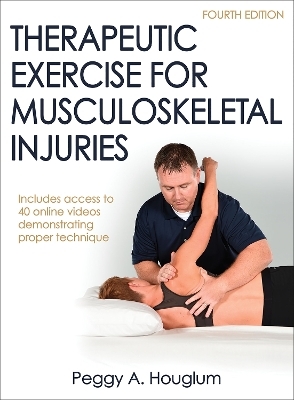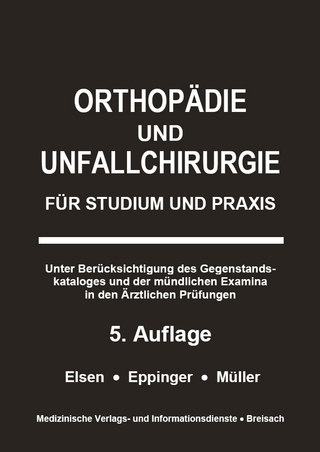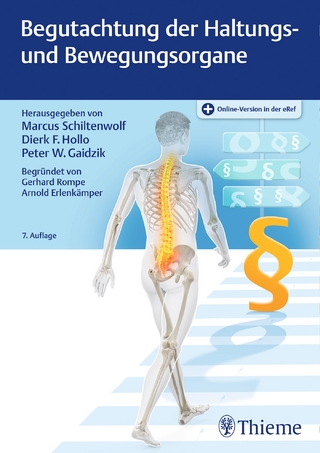
Therapeutic Exercise for Musculoskeletal Injuries
Human Kinetics (Verlag)
978-1-4504-6883-1 (ISBN)
- Titel erscheint in neuer Auflage
- Artikel merken
Therapeutic Exercise for Musculoskeletal Injuries, Fourth Edition With Online Video, presents foundational information that instills a thorough understanding of rehabilitative techniques. Updated with the latest in contemporary science and peer-reviewed data, this edition prepares upper-undergraduate and graduate students for everyday practice while serving as a referential cornerstone for experienced rehabilitation clinicians. The text details what is happening in the body, why certain techniques are advantageous, and when certain treatments should be used across rehabilitative time lines. Accompanying online video demonstrates some of the more difficult or unique techniques and can be used in the classroom or in everyday practice.
The content featured in Therapeutic Exercise for Musculoskeletal Injuries aligns with the Board of Certification’s (BOC) accreditation standards and prepares students for the BOC Athletic Trainers’ exam. Author and respected clinician Peggy A. Houglum incorporates more than 40 years of experience in the field to offer evidence-based perspectives, updated theories, and real-world applications.
The fourth edition of Therapeutic Exercise for Musculoskeletal Injuries has been streamlined and restructured for a cleaner presentation of content and easier navigation. Additional updates to this edition include the following:
• An emphasis on evidence-based practice encourages the use of current scientific research in treating specific injuries.
• Full-color content with updated art provides students with a clearer understanding of complex anatomical and physiological concepts.
• 40 video clips highlight therapeutic techniques to enhance comprehension of difficult or unique concepts.
• Clinical tips illustrate key points in each chapter to reinforce knowledge retention and allow for quick reference.
The unparalleled information throughout Therapeutic Exercise for Musculoskeletal Injuries, Fourth Edition, has been thoroughly updated to reflect contemporary science and the latest research. Part I includes basic concepts to help readers identify and understand common health questions in examination, assessment, mechanics, rehabilitation, and healing. Part II explores exercise parameters and techniques, including range of motion and flexibility, proprioception, muscle strength and endurance, plyometrics, and development. Part III outlines general therapeutic exercise applications such as posture, ambulation, manual therapy, therapeutic exercise equipment, and body considerations. Part IV synthesizes the information from the previous segments and describes how to create a rehabilitation program, highlighting special considerations and applications for specific body regions.
Featuring more than 830 color photos and more than 330 illustrations, the text clarifies complicated concepts for future and practicing rehabilitation clinicians. Case studies throughout part IV emphasize practical applications and scenarios to give context to challenging concepts. Most chapters also contain Evidence in Rehabilitation sidebars that focus on current peer-reviewed research in the field and include applied uses for evidence-based practice. Additional learning aids have been updated to help readers absorb and apply new content; these include chapter objectives, lab activities, key pointts, key terms, critical thinking questions, and references. Instructor ancillaries, including a presentation package plus image bank, instructor guide, and test package, will be accessible online.
Therapeutic Exercise for Musculoskeletal Injuries, Fourth Edition, equips readers with comprehensive material to prepare for and support real-world applications and clinical practice. Readers will know what to expect when treating clients, how to apply evidence-based knowledge, and how to develop custom individual programs.
Peggy A. Houglum, PhD, is a retired associate professor at the Rangos School of Health Sciences at Duquesne University in Pittsburgh. She has more than 40 years of experience as a certified athletic trainer and licensed physical therapist, providing patient and athlete care in a variety of settings, including university athletic training facilities, sports medicine clinics, rehabilitation hospitals, acute care hospitals, burn care, workers’ compensation clinics, and extended care facilities. She has also served as an athletic trainer with the United States Olympic Sports Festivals, Olympic Games, and World University Games. Houglum’s extensive background as a certified athletic trainer, physical therapist, clinical and classroom educator, and program director provides her with a unique perspective on the appropriate use of therapeutic exercise techniques in rehabilitation programs for treatment of athletic injury. In 1991, Houglum created the National Athletic Trainers’ Association’s (NATA) first formal continuing education program. Since that time, Houglum has served as chair of the NATA Continuing Education Committee and as a member of the organization’s Education Council and the Council on Employment. In 2002, she was named to the NATA Hall of Fame, the association’s highest honor, and received NATA’s Most Distinguished Athletic Trainer Award in 1996. In 2009, Houglum was named Most Influential Rehabilitation Professional in Physical Therapy by Therapy Times. Houglum is a member of the American Physical Therapy Association and its Sports Medicine Section. She is also a member of NATA and served on the NATA’s CEPAT committee and the BOC’s Role Delineation #6 and #7 Committees. Houglum continues to serve as associate editor for Sports Rehabilitation. Houglum was keynote speaker at the 2011 Hong Kong Society for Surgery of the Hand Conference, where she made two additional presentations. She has contributed to the advancement of sport rehabilitation through several international, national, and regional presentations. Over the years she has coauthored textbooks, written journal articles, and contributed chapters to sports medicine texts. Houglum enjoys spending time with family and friends, reading, painting, biking, and snowshoeing. She resides in Cedar Grove, Wisconsin.
Part I. Basic Concepts
Chapter 1. Concepts of Rehabilitation
The Rehabilitation Team
Athletic Trainer as Rehabilitation Clinician
Qualities of Professionalism
Components of a Rehabilitation Program
Evidence-Based Practice and Outcomes-Based Practice
Basic Components of Therapeutic Exercise
Return-to-Competition Criteria
Psychological Considerations
Summary
Learning Aids
Chapter 2. Concepts of Healing
Primary and Secondary Healing
Healing Phases
Growth Factors
Healing of Specific Tissues
Tensile Strength During Healing
Factors That Affect Healing
Role of Therapeutic Exercise in Healing
Summary
Learning Aids
Chapter 3. Concepts of Physics in Therapeutic Exercise
Force
Newton’s Laws of Motion
Center of Gravity
Stability and Fixation
Body Levers
Levers and Force
Physiological Muscle Advantages
Other Concepts related to Muscle Function
Summary
Learning Aids
Chapter 4. Examination and Assessment for Rehabilitation
Subjective and Objective Examination: Making a Profile
Interpreting Results and Designing a Rehabilitation Program
Keeping Rehabilitation Records
Summary
Learning Aids
Part II. Therapeutic Exercise Parameters and Techniques
Chapter 5. Range of Motion and Flexibility
Defining Flexibility and Range of Motion
Connective-Tissue Composition
Effects of Immobilization on Connective Tissue
Effects of Remobilization on Connective Tissue
Mechanical Properties and Tissue Behavior in Range of Motion
Neuromuscular Influences on Range of Motion
Determining Normal Range of Motion
Measuring Range of Motion
Terminology in Goniometry
Stretching Techniques
Exercise Progression
Special Considerations
Summary
Learning Aids
Chapter 6. The ABCs of Proprioception
Neurophysiology of Proprioception
Central Nervous System Proprioceptor Sites
Balance
Coordination
Agility
Therapeutic Exercise for Proprioception
Summary
Learning Aids
Chapter 7. Muscle Strength and Endurance
Neuromuscular Physiology
Muscle Structure and Function
Whole-Muscle Function
Fast- and Slow-Twitch Fibers
Muscle Strength, Power, Endurance, and Recovery
Force Production
Types of Muscle Activity
Open and Closed Kinetic Chain Activity
Evaluating Muscle Strength
Gradations of Muscle Activity
Strengthening Principles
Programs of Goal Progressions
Summary
Learning Aids
Chapter 8. Plyometrics
Neuromuscular Principles
Plyometric Production
Plyometric Exercise Phases
Pre-Plyometric Considerations
Plyometric Program Design
Plyometric Program Considerations
Precautions and Contraindications
Equipment
Lower-Extremity Plyometrics
Upper-Extremity and Trunk Plyometrics
Summary
Learning Aids
Chapter 9. Functional and Performance-Specific Development
Definitions, Foundations, and Goals
Contributions to Therapeutic Exercise
Basic Functional Activities
Performance-Specific Exercises
Progression from Functional Exercises to Performance-Specific Development
Precautions
Final Evaluation
Lower-Extremity Functional and Performance-Specific Progression
Upper-Extremity Functional and Performance-Specific Progression
Returning the Patient to Full Participation
Summary
Learning Aids
Part III. General Therapeutic Exercise Applications
Chapter 10. Posture and Body Mechanics
Posture
Muscle Imbalances
Body Mechanics
Body-Awareness Programs
Summary
Learning Aids
Chapter 11. Ambulation and Ambulation Aids
Normal Gait
Clinical Gait Analysis
Pathological Gait
Normal Running Gait
Mechanics of Ambulation With Assistive Devices
Summary
Learning Aids
Chapter 12. Aquatic Therapeutic Exercise
Physical Properties and Principles of Water
Indications, Advantages, Precautions, and Contraindications
Aquatic Therapeutic Exercise Principles and Guidelines
Deep-Water Exercise
Aquatic Therapeutic Exercises
Summary
Learning Aids
Chapter 13. Manual Therapy
Critical Analysis
Massage
Myofascial Release
Myofascial Trigger Points
Muscle Energy
Proprioceptive Neuromuscular Facilitation
Other Manual Therapies
Joint Mobilization
Summary
Learning Aids
Chapter 14. Therapeutic Exercise Equipment
Range-of-Motion Equipment
Resistive Equipment
Swiss Balls
Foam Rollers
Aquatic Equipment
Manual Therapy Equipment
Plyometric Equipment
Summary
Learning Aids
Chapter 15. Total Body Considerations
Activity Levels, Stages of Life, and Health Care
Pediatric Considerations
Geriatric Considerations
Joint Replacement
Tendinopathy
Summary
Learning Aids
Part IV Specific Applications
Chapter 16. Creating the Rehabilitation Program
Program Contents
Phases of Rehabilitation and Therapeutic Exercise
Individualization of Therapeutic Exercise
Summary
Learning Aids
Chapter 17. Sacroilium and Pelvic Stabilization
General Rehabilitation Considerations
Rehabilitation Techniques
Pathological Sacroilial Alignment
Special Rehabilitation Applications
Summary
Learning Aids
Chapter 18. Spine
General Rehabilitation Considerations
Rehabilitation Techniques
Special Rehabilitation Applications
Summary
Learning Aids
Chapter 19. Shoulder and Arm
General Rehabilitation Considerations
Rehabilitation Techniques
Flexibility Exercises
Strengthening Exercises
Stabilization and Proprioception Exercises
Plyometric Exercises
Functional and Performance-Specific Exercises
Special Applications for Rehabilitation
Summary
Learning Aids
Chapter 20. Elbow and Forearm
General Rehabilitation Considerations
Rehabilitation Techniques
Joint Mobilization
Flexibility Exercises
Strengthening Exercises
Functional and Performance-Specific Activities
Special Rehabilitation Applications
Summary
Learning Aids
Chapter 21. Wrist and Hand
General Rehabilitation Considerations
Soft-Tissue Mobilization
Joint Mobilization
Flexibility Exercises
Strengthening Exercises
Plyometric Exercises
Functional and Performance-Specific Exercises
Special Rehabilitation Applications
Summary
Learning Aids
Chapter 22. Foot, Ankle, and Leg
General Rehabilitation Considerations
Common Structural Deformities
Orthotic Treatment for Foot Deformities
Determining Proper Footwear for Patients
Soft-Tissue Mobilization
Deep-Tissue Massage
Joint Mobilization
Flexibility Exercises
Strengthening Exercises
Proprioception Exercises
Functional and Performance-Specific Exercises
Special Rehabilitation Applications
Summary
Learning Aids
Chapter 23. Knee and Thigh
General Rehabilitation Considerations
Soft-Tissue Mobilization
Joint Mobilization
Flexibility Exercises
Strengthening Exercises
Proprioception Exercises
Functional and Performance-Specific Exercises
Special Rehabilitation Applications
Summary
Learning Aids
Chapter 24. Hip
General Rehabilitation Considerations
Soft-Tissue Mobilization
Joint Mobilization
Flexibility Exercises
Strengthening Exercises
Proprioception Exercises
Functional and Performance-Specific Exercises
Special Rehabilitation Applications
Summary
Learning Aids
| Erscheinungsdatum | 23.07.2016 |
|---|---|
| Verlagsort | Champaign, IL |
| Sprache | englisch |
| Maße | 216 x 279 mm |
| Gewicht | 2926 g |
| Themenwelt | Sachbuch/Ratgeber ► Sport |
| Medizinische Fachgebiete ► Chirurgie ► Unfallchirurgie / Orthopädie | |
| Medizin / Pharmazie ► Medizinische Fachgebiete ► Sportmedizin | |
| Medizin / Pharmazie ► Physiotherapie / Ergotherapie ► Rehabilitation | |
| ISBN-10 | 1-4504-6883-7 / 1450468837 |
| ISBN-13 | 978-1-4504-6883-1 / 9781450468831 |
| Zustand | Neuware |
| Haben Sie eine Frage zum Produkt? |
aus dem Bereich



